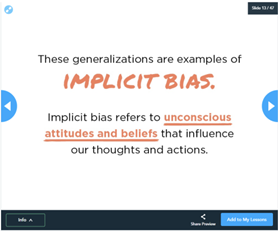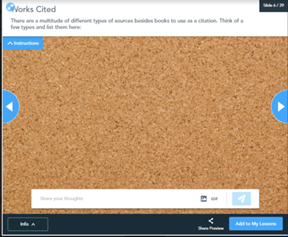 Nearpod Library: Visiting the Great Pyramid of Giza
Nearpod Library: Visiting the Great Pyramid of GizaTool Snapshot
| Price | Silver: FreeGold: $159/year; Platinum: $397/year; Premium Plus: Custom |
|---|
| Type of learning | Behaviorism Cognitivism |
|---|
| Ease of Use | ★★★★✩ |
|---|
| Privacy | ★★★★✩ |
|---|
| Accessibility | ★★★★★ |
|---|
| Class Size | 40/70/90/250 |
|---|
| Login Required | Teachers need a login. Students can join a presentation via a code rather than logging in. |
|---|
| ISTE Standards for Students | Empowered Learner |
|---|
| COPPA/FERPA Compliant | COPPA/FERPA/CCPA/ SOPPA/GDPR/LGDP compliant. |
|---|
Price
This tool has 4 different pricing plans that vary according to the type of plan you are looking for. The free plan (Silver) has minimal features (100MB of storage, only one active session, no co-teaching, no student accounts, and only allows 40 students to join). The Gold plan, which is $159 per year, includes some additional features and increases the number of students to 70. Platinum, which is $397 per year, has the same features as Gold but increases storage and the number of students to 90. Lastly, there is Premium Plus in which the price varies based on the district. This plan allows for unlimited storage, 250 students per lesson, adds many additional features, and is designed specifically for schools and districts. Because Nearpod has a variety of plans, which can get high in price, this creates a gap for districts that don’t provide their educators with the appropriate funding for teaching tools.
Type of Learning
Because Nearpod includes guided learning, immediate feedback, and question, and answer, it supports behavioral learning. Nearpod also supports cognitive learning as students have the opportunity to self-explore the lessons provided by their teachers as well as gives the students the flexibility to organize the information in a way that works best for them.
 Example self-guided presentation on Nearpod
Example self-guided presentation on Nearpod Example post-lesson assessment on Nearpod
Example post-lesson assessment on NearpodEase of Use
We gave Nearpod 4 stars instead of 5 for ease of use because of the amount of time it may take for users to learn how to use the tool - both students and teachers. There are many different tools and activities teachers must familiarize themselves with prior to using this tool in a classroom, but once familiar, the opportunities for teaching with Nearpod are close to endless. Nearpod also has tutorials and videos so that students and teachers can learn how to navigate the website and learn about all its features prior to usage.
Privacy
Nearpod complies with both COPPA and FERPA, as well as laws specific to states such as CCPA and Nevada SB 220. Nearpod also “complies with the EU-US Privacy Shield Framework as set forth by the US Department of Commerce and the provisions of the European General Data Protection Regulation (“GDPR”) regarding the collection, use, and retention of personal information from European Union, and the United Kingdom to the United States” (Nearpod Privacy Policy, GDPR, 2021, para. ?). The reason we give Nearpod 4 stars instead of five is that the information Nearpod collects changes based on how you’re accessing the Nearpod, (either website and/or app), as well as if you have a personal account, or are accessing the Nearpod as a student, via a student account. For student accounts specifically, their first name, last name, email address, the name of the Institution that the student belongs to, reference account number, and an optional profile photo are collected.
Accessibility
We give Nearpod 4.5/5 stars for accessibility. The tool is very simple to navigate when doing the no-mouse challenge. Nearpod also uses Immersive Reader “to provide text-to-speech, translation, contrast, and additional text accessibility features within a lesson. Immersive Reader is compatible with many of Nearpod’s content & activity features, however, Immersive Reader does not read text on images. This feature is available on both the web and iOS app versions of Nearpod” (Nearpod Accessibility Statement). And, while most of the features can integrate with screen readers, Nearpod cannot read questions or answers for Memory Test, Fill-in-the-Blank, or Time to Climb activities. A big plus is that all of Nearpod’s videos offer closed captioning, including uploaded Youtube videos. Lastly, another benefit of Nearpod is that it offers 12 different media types, so there is something for everyone. Nearpod aligns with the Universal Design for Learning, as the 12 media types allow for Multiple Means of Engagement for students, it is compatible with Immersive Reader which allows for Multiple Means of Representation, and lastly, because Nearpod has so many different forms of assessment, there are Multiple Means for Action and Expression.
Class Size
As stated in the pricing, class size varies based on the plan purchased. The free plan allows for 40 participants, for $159 you can have up to 70 students, for $397 you are allowed 90, and for the suggested school/district plan, up to 250 students can join a class.
Login
Once the teachers have created an account, just by going to www.nearpod.com students are able to enter a room code for the specific lesson created by their teacher. Students are not required to give their email or full name to use Nearpod. Teachers must log in using their school email and password, or through any of four third-party apps: Google, Office 365, Clever, or ClassLink.
ISTE Standards
Nearpod fits into the Empowered Learner ISTE Standard because students leverage the tools Nearpod provides them with in order to demonstrate their learning of critical content. Students are provided with a whole host of tools through Nearpod such as Drag & Drop, Draw It, Open-Ended Question, Quiz, Poll, Collaborate Board, Fill in the Blanks, Matching Pairs, and Time to Climb (Nearpod Formative Assessment).
Top 3 Things to Know About Nearpod Video

 Watch on YouTube
Watch on YouTubeVideo Transcript
Nearpod & the SAMR Model
Dr. Ruben Puentedura’s SAMR model offers a lens for examining how technology is adopted in a classroom. As you strive to incorporate online tools into your classroom, we encourage you to use this model as an analytic tool.
Here is an example of how Nearpod might fit within the SAMR model, in the context of replacing a traditional presentation in the classroom with a PowerPoint:
- Substitution: Instead of presenting a traditional PowerPoint at the front of the class, teachers import presentations into Nearpod and present them using the Live Lesson feature.
- Augmentation: Teachers include polls and discussion questions interspersed throughout presentations that students can reply to in real-time and view the results to further the discussion and see the thoughts of their peers. Students can see the slides on their own devices and follow along at their own pace
- Modification: Instead of traditional exit tickets and understanding checks, teachers can implement a Nearpod game such as “Time to Climb” so that students can compete in a fun and interactive way to demonstrate their understanding of the day’s lesson. This will help students to be more engaged and also improve interactions among peers, instead of each student sitting in silence taking a multiple-choice quiz.
- Redefinition: Instead of teaching the same presentation to the entire class, teachers can use Nearpod to create individual, interactive lessons for small groups of students that can be navigated at the students’ own pace, both in school and at home. Teachers can check in by viewing answers to embedded questions and polls, and a blend of slides, videos, links to readings, and virtual forums can be used.
Far too often, technology is used as a direct substitute for other low-tech tools (e.g., pencil and paper). While substitution has some benefits (e.g., students develop their technology skills and knowledge), we encourage you to think about how you might use Nearpod to modify or redefine learning.
Learning Activities
Math
The teacher can conduct a lesson in graphing exponential functions using Nearpod as a presentation tool. The teacher might start by opening with a poll to gauge how much background knowledge students have: do they know a lot, a little, or nothing about graphing exponential functions? Based on this, the teacher will know whether students will be able to work entirely independently, with a little bit of support, or with a lot of support. Then, the teacher can present the lesson on graphing. Afterward, they can instruct students to watch a video on the topic embedded in the presentation. Allowing students to watch it individually instead of as a class provides students with more comfort because they can go at their own pace, turn on closed captioning if they need it, and pause or rewind to strengthen their understanding. Students will then work in groups to practice graphing, and the lesson will end with the same poll that it started with so the teacher can see how much each student improved over the course of the lesson.
Science
The teacher can use Nearpod to create a science research report workshop. Link resources in the presentation that help students learn how to structure citations and their research reports as a whole. Embed an activity where students are given an article, its author, its year of publishing, and the journal it was published in, and have them submit a citation using this information so that the teacher can see if they understand how to correctly structure one. Link web pages and videos on potential topics for the students to write their research reports about. Afterward, archive the lesson so that students can revisit it at any time and refresh their understanding.
English/Language Arts
Teachers can use Nearpod to create an online discussion forum with students across multiple classes and even schools about a book that they have read, i.e. Catcher in the Rye. Give both class time and homework time for students to engage in open discussion with their peers so they can expand their horizons past one classroom.
Other
- Entrance and exit tickets.
- Linked videos that students can watch at their own pace/in their own time.
- Discussion forums.
- Games.
- Polls and surveys.
 Example multiple choice quiz in Nearpod
Example multiple choice quiz in Nearpod Example "share your thoughts" screen on Nearpod
Example "share your thoughts" screen on NearpodResources
How to Use Nearpod
For Teachers
- Go to https://nearpod.com.
- Click “Sign Up for FREE” and select “Teacher.”
- Register for an account.
- Create a lesson.
- Import PowerPoint or Google Slides, or create a presentation from scratch.
- Include any polls, discussion questions, or quizzes desired.
- Give access code to class.

For Students
- Go to https://nearpod.com.
- Enter the join code provided by the teacher in the box that says “STUDENTS Join a Lesson.”
- Participate in a guided lesson.

Research
Burton, R. (2019). A review of Nearpod - an interactive tool for student engagement. Journal of Applied Learning & Teaching, 6(2), 95-97. https://journals.sfu.ca/jalt/index.php/jalt/index
Civelek, M., Karatepe, C. (2021). The impact of student-paced pragmatics instruction through Nearpod on EFL learners’ request performance. Advances in Language and Literary Studies, 12(6), 67-78. http://journals.aiac.org.au/index.php/alls/article/view/7106
Sanmugam, M., Selvarajoo, A., Ramayah, B., Lee, K. (2019). The use of Nearpod is an interactive learning method. 2019 International Technology, Education and Development Conference Proceedings, 8908-8915. https://www.researchgate.net/profile/Anurita-Selvarajoo/publication/332285774_USE_OF_NEARPOD_AS_INTERACTIVE_LEARNING_METHOD/links/5e78e5e392851c309137c71e/USE-OF-NEARPOD-AS-INTERACTIVE-LEARNING-METHOD.pdf
Buttrey, K. (2021). Inclusion, engagement, and Nearpod: Providing a digital alternative to traditional instruction. The Journal of the Teacher Education Division of the Kentucky Council for Exceptional Children, 8(1). https://digitalcommons.murraystate.edu/ktej/vol8/iss1/2/
Authors
This page was created by Clare Simpson and Hannah Walz.